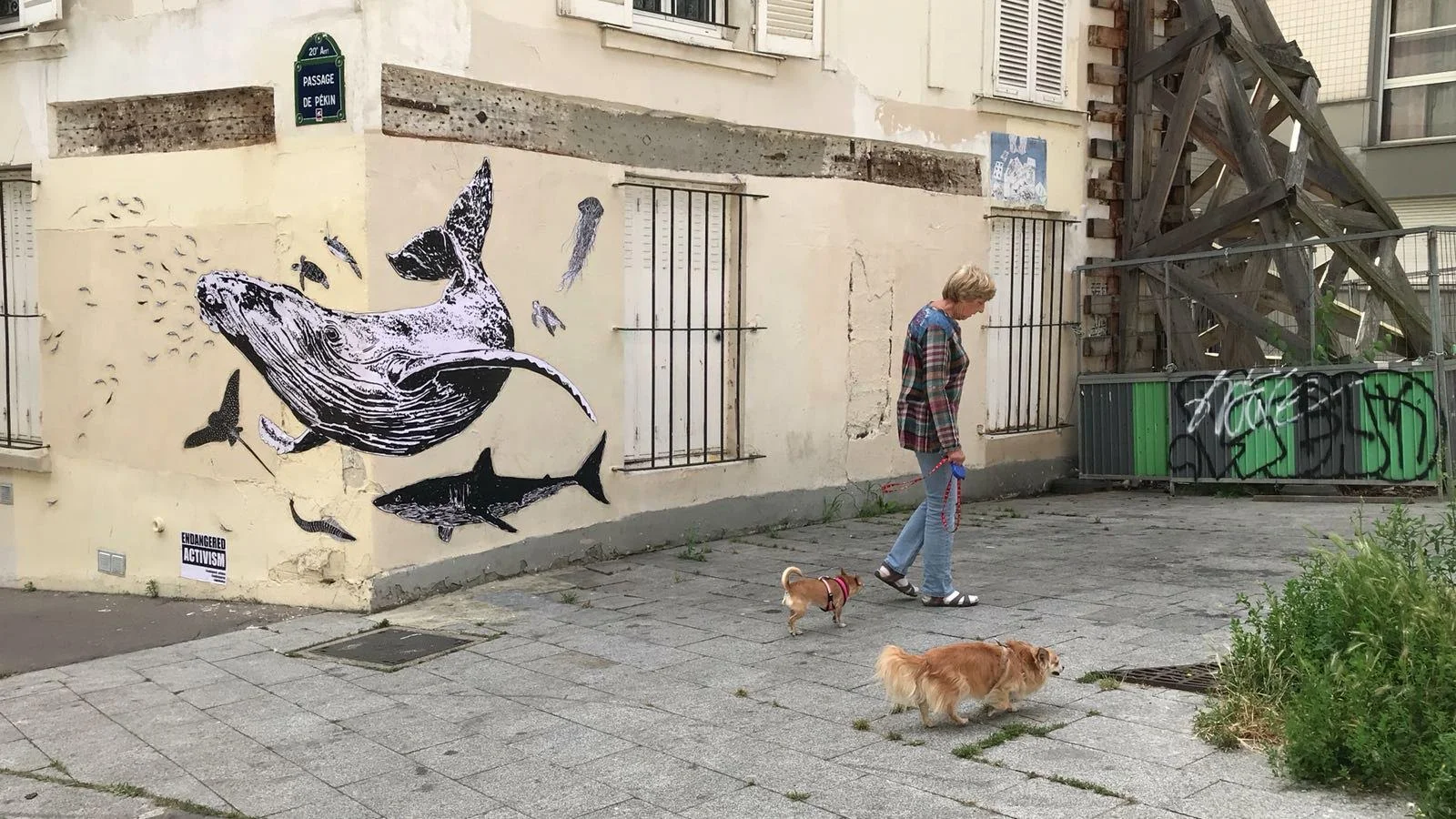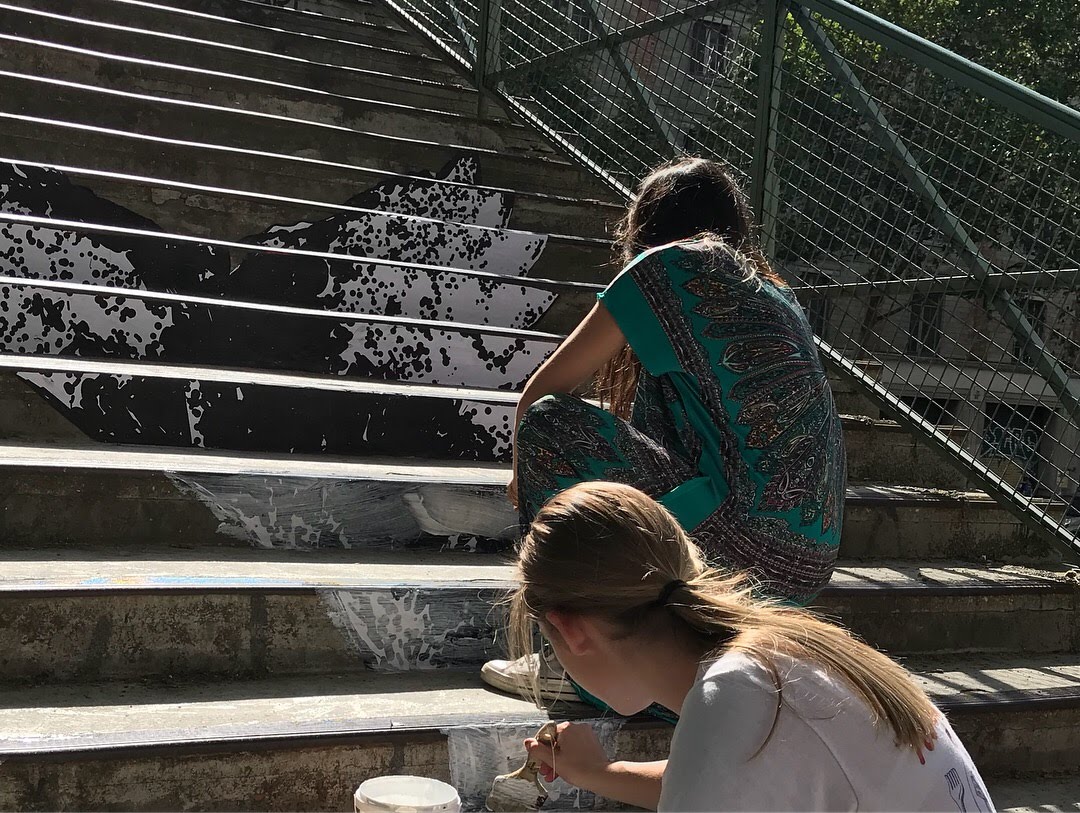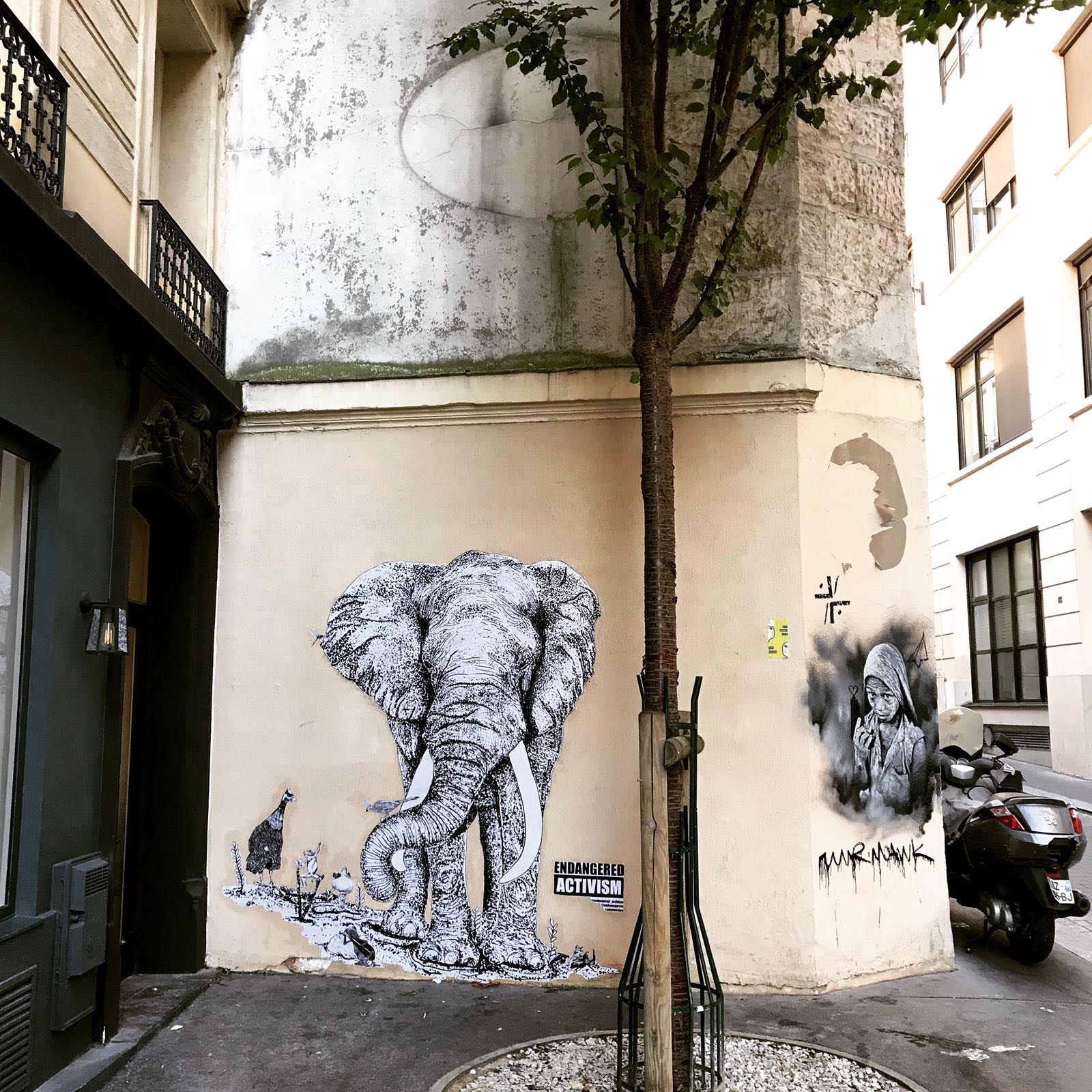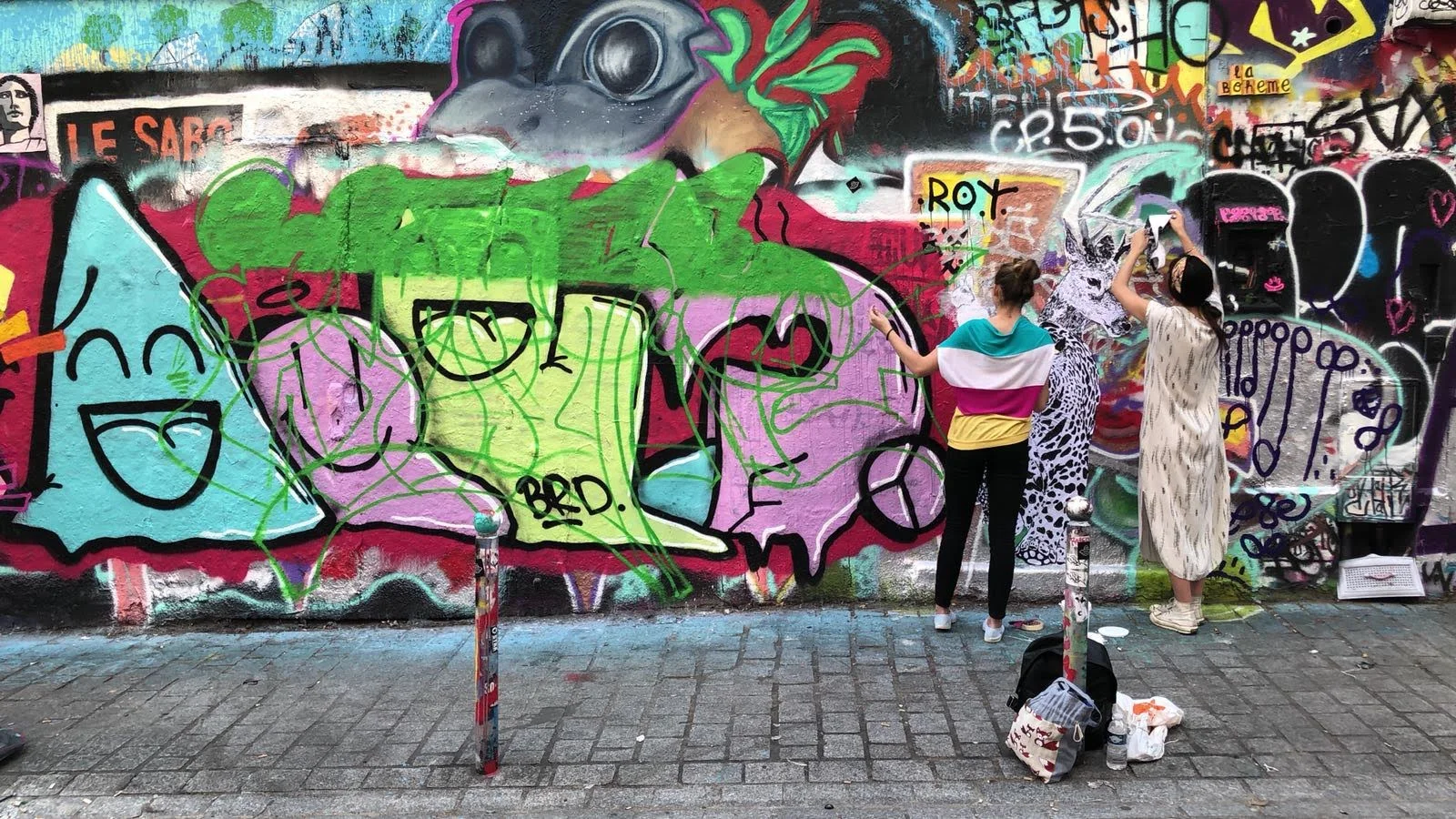what we lose
A collaboration with Diana garcia
Endangered Activism and Mexican artist, Diana Garcia, collaborated on a series of endangered animal drawings to be pasted up around cities as street art to bring the conservation conversation into urban environments and public spaces. The series of animals launched #WhatWeLose in Paris, France in June 2018 with a city-wide takeover. We returned in July 2019 to install a new snow leopard and several were still in place a year later. We were invited to Oxford, England to install the series at the Historic Covered Market as the first street art installation in the city. Our third full series was installed in Denver, Colorado for CRUSH Walls. We had a brief installation in our hometown of Breckenridge, Colorado which we installed on the day of the Global Climate Strike in 2019 but it was removed just two weeks later.
Looking at specific endangered species that uniquely impact their environment #WhatWeLose illustrates how their extinction would effect more than just one species, but would create a ripple effect throughout the entire ecosystem.
The story of each animal showcased in this series will revealed along with photos of the finished pastings from Paris and Oxford in July after our second art residency in Oxford, England on June 29th and 30th, 2018.
More city takeovers and animals are being planned for 2018 and beyond. Stay tuned and follow the journey on instagram. If you find pastings in your city please tag #WhatWeLose and @endangered_activism. If you want to bring this project to your community feel free to contact us through our contact page.
Devon and Diana are collaborating on a illustrated book created with these and additional drawings combined with Devon’s research on endangered species and their contribution to our world to raise awareness of ‘What We Lose’ when we ignore wildlife extinction as a way to reach kids and their parents.
MEET THE CHARACTERS:
OHANA
We named our whale Ohana, after the Hawaiian word for family. Several species of whales are endangered and all will have a dramatic affect on the health of oceans. The blue whale is the largest mammal on earth and if we lose them we will see dramatic changes in the oceans and the climate overall. Whales are vital to the ocean’s food chain and ecosystem in several ways: They help circulate the ocean like a pump by distributing nutrients to deeper waters with their diving, while their nitrogen rich poo helps provide nutrients for phytoplankton to flourish which actually absorbs carbon from the air affecting climate change. Phytoplankton is also a source for many animals, including the krill that blue whales eat. Even when whales die they are vitally important to the ecosystem as they sink to the bottom to provide multiple tons of food for marine animals in the lower depths. Their only predator are humans so it’s up to us to prevent their extinction and keep the ecosystem in balance. 🐋
FULONG
Fulong was drawn based off a sunbear we met in Borneo in November 2017 at the Borneo Sunbear Conservation Center in Sandakan, Sabah. Sunbears are the world’s smallest bear and have a beautiful golden ’necklace’ whose pattern is completely unique to each bear. Sunbears do not hibernate, they build nests in trees to sleep in. They have a very long tongue which helps they get honey out of bee hives and that has earned them the nickname of ‘honey bears’ locally. Sunbears are the farmers and the gardeners of the environment and help ensure the health of the forest. They disperse seeds, keep the termite population in check which helps the tropical tree species. They dig in the soil for grubs and that helps mix the soil. They also create nesting sites for animals like hornbills and flying squirrels (both of which are featured in the artwork with our sunbear) by tearing open tree trunks to reach the honey inside. if they they are allowed to go extinct many other species will be affected. Sunbears face habitat loss due to deforestation due to logging and the rapid development of palm oil plantations. They are sought after for the illegal pet trade because of their size and adorable look, which means cubs are stolen from their mothers who are often killed and then kept in cages for the rest of their lives. They are also commercial hunted for their gall bladders used in Chinese medicine and their bear paws as an expensive delicacy. Because the sunbears are so integral to the environment they live in and to other animals for creation of homes, the entire ecosystem is affected when we lose sunbears.
ETOSHA
We named our African elephant, Etosha in honor of our first research trip in Namibia in July 2017 where we first saw desert adapted elephants in the skeleton coast and again during a visit to Etosha National Park. Elephants were an obvious choice for #WhatWeLose because as the largest land animal their presence, or lack of, is impactful in many ways. One of the most unique ways is highlighted in a recent Scientific American article about their footprints. If we lose elephants we lose their footprints and each imprint left behind has the potential to become a micro habitat capable of supporting over 60 species! When they walk, they leave large impressions, some up to 30 cm deep, that fill up with water creating poolsin which many creatures lay eggs and breed and others may use for drinking water. The biodiversity of species that depends upon an elephant’s footprint has been found to number near a thousand. Elephants were already known to be integral to the environment as important seed distributors due to their large manure contributions across their large ranges of travel but the elephant’s footprint is proving to have its own important role within the lifecycle of many species!
All species of elephants are under threat from habitat loss and climate change. Poaching for ivory and illegal game hunting still affects elephant populations despite the work being done to protect them. We are only beginning to understand how much we have to lose with the extinction of elephants and it is up to this generation to help ensure it’s not too late!
YO'OKO
Meet Yo’oko. Pasted up in the 10th arr. We named him in honor of Yo’oko, a young male jaguar who had been spotted roaming the Huachuca Mountains southeast of Tucson, Arizona. We heard today he was found dead. There is one other male named Sombra still believed to living in the US. Jaguars used to populate the American Southwest, but their numbers plummeted in the region over the last 150 years due to habitat loss and hunters who killed them off because they threatened livestock. The last known female jaguar in the U.S. was killed in 1963. You can learn more with the Northern Jaguar Project based in Tucson, Arizona.
THE BUMBLEBEES
The neighborhood of ‘Babelville’ rests at the base of Belleville. Their urban gardenboxes now have some endangered rusty patched bumblebees. It is the first bumblebee to be listed as endangered in the US. Bumblebees face steep decline worldwide which affects all species including humans as they are among the most important pollinators of crops and the only insect pollinators of tomatoes. If bees go extinct, plants die, if plants die, animals die, if animals die, we die. This tiny little creature is vital to the entire food chain for all the species on earth. You can help bumblebees decline in your own backyard by planting native flowers, avoiding pesticides, and fostering natural landscapes that attract a diversity of bees.
Tania
We named this beautiful jaguar in honor of Tania, who gave birth to two cubs in San Alonso in June 2018 as part of Conservation Land Trust’s jaguar breeding program in Ibera, a region of northern Argentina that is part of their rewildling program throughout several provinces in Argentina. This is the first jaguar in their program to give birth and her cubs will be raised wild as part of the long term vision of their species reintroduction plan in the region. Jaguars are important not just to rebalance the the ecosystem as an apex predator but they also hold an integral place in local culture and pride. We asked Diana to draw this jaguar with all of South American in mind to represent the jaguar corridor through multiple countries and regions and the diversity of species that depend up on the jaguars presence in their habitat to keep the balance.
DIANA GARCIA
Activist / Producer / Actress
Diana´s purpose is to share the message BE WHAT YOU DREAM. Her murals and street art Guardians, the Uniwolfcheetah, Jicuri and others, can been seen in multiple walls in Mexico and the USA. As an actress, she has embodied characters that have opened a conversation for different social issues. Some of these films caught the attention of various international festivals as Cannes, Toronto, Sundance and AFI. Speaker at TEDx Oaxaca in 2014. Producer of the social innovative Oaxacan festival, CATAPULTA.
@imdianagarcia
Rhino installation at CRUSH Walls, 2018 Denver, Colorado.





























